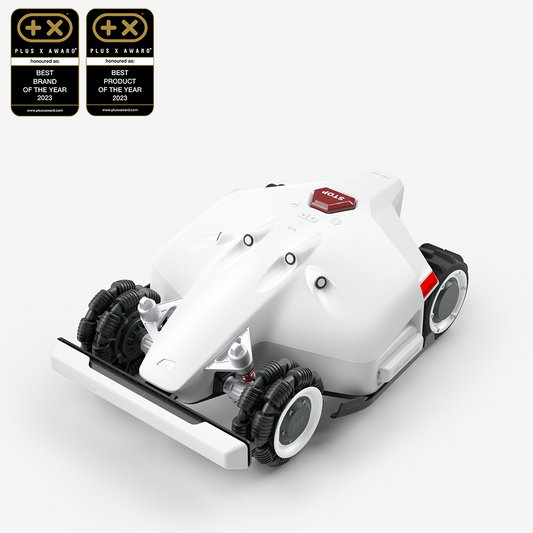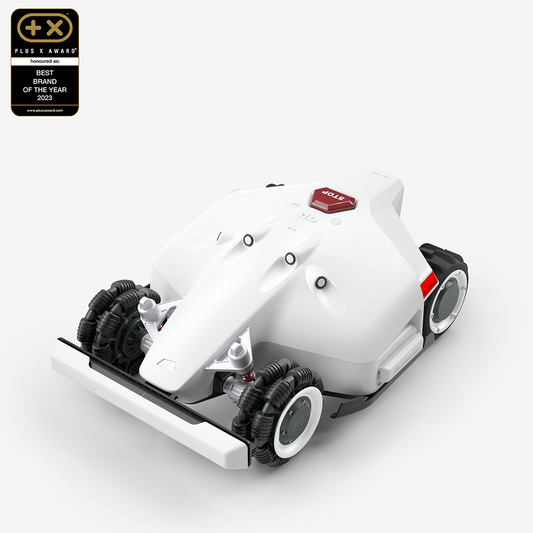Ultimate Guide to Top Models in Ireland
Robot lawn mowers have come a long way since their inception, and 2024 has seen a notable rise in the number of gardeners investing in these smart gadgets. With the array of models available, choosing the best robot lawn mower boils down to performance, installation ease, maintenance, and compatibility with your garden's size and complexity. The freedom from manual mowing and the assurance of a consistently manicured lawn make these machines particularly enticing.

As someone who keeps up with gardening trends, I've observed that the essential features prospective buyers look for include multi-zone management, weather-proofing, and autonomous navigation. The robustness of a mower like the LUBA 2 AWD 3000, which can handle varied terrain, demonstrates the advancements in this technology. Users appreciate the convenience of easy setup and minimal upkeep, alongside smart features that adapt to the unique contours and obstacles present in their gardens.
Key Takeaways
- Robot lawn mowers offer automation, ease of use, and consistently well-kept lawns.
- Selecting the best model requires considering installation ease, maintenance, and garden compatibility.
- Advanced features like multi-zone management and weather-proofing enhance the mowing experience.
Essential Features of Top Robot Lawn Mowers in 2024
As we explore the advancements in robotic lawn mowers for 2024, I'll highlight the paramount features that define the leading models, focusing on their technological sophistication and user-centric functionalities.
Cutting Efficiency and Deck Design
The cutting deck is a crucial component of any robot mower; it houses the cutting blades and shapes how well the robot can manage your lawn. The top models boast a cutting width that balances swift cutting with intricate manoeuvrability. Moreover, blades are designed to finely mulch the clippings, fostering a healthier lawn.
Battery Performance and Power Management
Battery life and capacity significantly influence a robotic lawn mower's effectiveness. Models equipped with lithium-ion batteries lead the pack, ensuring longer runtimes and consistent power delivery. Innovations in power management mean these robots can cover substantial areas, like the one found in the Gardena Sileno Life 1250 m², on a single charge.
Smart Navigation and Sensors
Navigation systems enhanced by GPS technology and sophisticated sensors guide robotic mowers across complex gardens. Satellite-positioning technology allows for meticulous lawn coverage, ensuring no area is missed. Highly developed programming also enables these mowers to adapt to obstacles and inclines dynamically.
Connectivity and Smart Control
With Bluetooth and Wi-Fi integrations, controlling a robotic mower is more intuitive than ever. Using a companion app, I can start, stop, and monitor my mower from the convenience of my mobile device, making it a seamless addition to my array of smart home devices.
Safety and Security Systems
Safety features in robotic mowers include sensors that stop the blades if the mower is lifted. Additionally, security features like GPS theft tracking and anti-theft alarms are integral. These systems ensure that in the unfortunate event of theft, I could potentially track and recover the robot, mitigating the risk of loss.
Installation and Setup

When I approach robotic lawn mower installation, I consider it a crucial step to ensure optimal performance. The process typically involves setting up perimeter wires, establishing the charging station, and configuring the initial programming for precise lawn navigation.
Perimeter and Guide Wire Setup
Perimeter and guide wires are essential for defining the mowing area and guiding the mower through more complex gardens. For example, the EcoFlow Blade requires laying a boundary wire around the lawn's edges and any obstacles. This wire emits a signal that the mower detects, preventing it from wandering outside the designated cutting area. Correct installation of these wires is fundamental, as it influences both the safety and the effectiveness of the mower.
Charging Station and Docking
The charging station should be placed on a flat surface near a power source. For AC-powered models like the LUBA 2 AWD 3000, the docking station acts as a home base where the mower returns once the job is done or when it needs recharging. Securing the docking station properly ensures the mower can easily locate and return for docking without manual assistance.
Initial Programming and Lawn Mapping
Robotic lawn mowers typically require initial programming to operate effectively. This means setting up multi-zone schedules and adjusting the cutting height according to your lawn's needs. The LUBA 2 AWD 3000 boasts intelligent navigation systems that allow for detailed lawn mapping, which the mower uses to navigate through complex gardens. It adapts its pattern to the garden's shape and size, ensuring every corner is maintained to the same standard.
Maintenance and Upkeep
When it comes to robot mowers, ensuring proper maintenance and upkeep is essential for optimal performance and longevity. I'll explore the key aspects such as regular cleaning, technical support, battery care, and tackling common issues to keep your robotic assistant in top shape.
Regular Cleaning and Blade Care
For the best lawn care, I recommend cleaning your robot mower after each use, focusing on removing grass clippings and debris that can clog the wheels and chassis. The cutting blades are vital, as they directly affect the quality of the mulch produced. Check and replace them as needed to maintain a clean cut, which will promote a healthier lawn.
Software Updates and Technical Support
Keeping your robot lawn mower's software current can enhance functionality and improve navigation with GPS technology. Most models, like the LUBA 2 AWD 3000, are equipped with Bluetooth and can connect to a companion app. It's important to regularly check for updates and contact technical support for any sensor malfunctions or glitches.
Battery Management and Storage
The battery life of your mower is critical. Lithium-ion batteries, often found in these machines, require proper care. I advise charging the battery fully before the first use and following the manufacturer's guidelines for storage, especially during the off-season. This will help preserve battery capacity and ensure reliable performance.
Troubleshooting Common Issues
If my robot lawn mower encounters issues, I start with the basics: checking for blockages, ensuring the battery is charged, and confirming that all settings in the mobile app are correct. For persistent issues, I consult the user manual or reach out to customer service. It's usually a straightforward fix, whether it's a GPS disruption or a minor sensor malfunction.
Landscaping Considerations for Robot Mowers

Before deploying a robot mower in your garden, it's crucial to assess the lawn size and its topography. This ensures that the chosen model can handle the specific demands of your garden, whether it accommodates multi-zones or features varied terrain.
Lawn Size and Terrain Adaptability
In my experience, the size of your lawn and the complexity of the terrain are pivotal factors when selecting a robot mower. For instance, the LUBA 2 AWD 3000 model is exceptional for handling steep slopes and uneven ground, making it a robust choice for gardens with challenging topography. Robot lawn mowers generally excel in lawns up to a certain size, beyond which they might require additional guidance or extended battery life.
- Push mowers are simplistic but labour-intensive for larger spaces.
- Riding mowers offer comfort but lack the automation robot mowers provide.
A typical robot lawn mower can handle inclines of about 20 degrees, but it's always wise to check the specifications for the maximum incline the model can manage, especially if your garden has significant hills and slopes.
Managing Multiple Zones and Complex Gardens
Complex gardens that encompass multiple zones require a robot mower with advanced navigation and the ability to follow multi-zone schedules. This is where features such as GPS tracking and the capacity to store multiple cutting schedules come into play.
Having a model that can be programmed to manage different garden sections on specific days or times is invaluable. It's essential for my robot mower to seamlessly transition between zones, ensuring each area receives the attention it needs with minimal manual intervention. This feature is extremely helpful for maintaining gardens that have separate lawns or divided sections with various grass types.
Product Comparisons and Recommendations

When selecting a robot lawn mower, it's important to consider the size of your garden, the complexity of its layout and your budget. Here's a guide that breaks down options across various categories to help you choose the right model for your needs.
Budget-Friendly Options
For those who desire the convenience of a robot lawn mower without a hefty price tag, budget-friendly models like the LawnMaster VBRM16 offer a practical solution. This mower delivers essential features such as moderate cutting width and basic navigation technology, ensuring a well-kept lawn without the bells and whistles of pricier counterparts. It's an affordable choice for gardeners who prioritise value for money.
Premium Models with Advanced Features
If you desire a model that boasts satellite-positioning technology and is equipped with anti-theft system, consider premium options like the Bosch range of robot mowers. These high-end mowers often come with enhanced security features and excellent tech specs, justifying their position in the higher price range. For gardens with complex layouts or intricate mowing requirements, investing in a premium model provides peace of mind and superior performance.
Best Robot Mowers for Small to Medium Gardens
Finding a robot mower that's tailored for small to medium-sized gardens means looking for one that's efficient in cutting width while remaining quiet during operation. Models like Worx and Roomba are known for their precision and ease of use, ideal for maintaining smaller areas without causing noise disruption. These mowers navigate through tighter spaces effectively and often come at a more affordable price compared to those designed for expansive lawns.
Frequently Asked Questions

As I explore the world of robotic lawn mowers, I'm often asked about the essential considerations for these smart garden tools. My focus here is to address some of the common inquiries I receive.
What features should be considered when selecting a robotic lawn mower for a large garden?
For large gardens, I find that battery life, cutting width, and the ability to handle varying terrain are pivotal. Models such as the Stihl iMOW 5 have demonstrated impressive performance for expansive areas.
How do robot lawn mowers perform compared to traditional mowers?
Robot lawn mowers are often lauded for their convenience and low noise levels. Their methodical cutting pattern can keep lawns consistently manicured, which is sometimes a contrast to the occasional uneven results from classic push mowers.
Which robot mower is the best for Irish weather?
Irish weather calls for a robot mower that is robust and weather-resistant. The Flymo EasiLife Go is often recommended for its ability to cope with wet conditions typical in Ireland.
What maintenance is required for robotic lawn mowers to ensure longevity?
Regular cleaning, blade inspection, and software updates are key to maintaining a robotic lawn mower. Ensuring the docking station is kept free from debris also contributes to the longevity of these machines.
Can robotic lawn mowers operate effectively without a perimeter wire, and if so, which models?
Some newer models can navigate without a perimeter wire by using advanced GPS or other technologies. However, finding models that excel in this capability requires thorough market research.
Which robotic mowers are recommended for small gardens, and what are their advantages?
In small gardens, compact models like the Flymo EasiLife Go 250 offer nimbleness and convenience, often with easier installation and lower costs.
How to evaluate the value for money when purchasing a robotic lawn mower?
I assess value for money by comparing the mower's features, durability, and after-sales support to its price. Reviews and comparisons, such as those provided by PCMag, can be instrumental in this evaluation.





